Strategy One
Connection Mapping
A connection map is a link between a Strategy user, a database connection, and a database login. It is used to apply database (row-level) security to a Strategy user. Connection mapping allows administrators to assign a user or group in the Strategy system to a specific login ID on the data warehouse RDBMS. The mappings are typically used to take advantage of one of several RDBMS data security techniques (security views, split fact tables by rows, and split fact tables by columns) that architects may have already created. When a database connection map is modified, Strategy Intelligence Server needs to be refreshed to recognize the changes.
Check out the video below to learn more!
Connection mapping is useful when Strategy users must be differentiated from each other at the data warehouse level or when they must be directed to separate data warehouses. These two scenarios are described below.
Connecting to the data warehouse using different database logins
In this scenario, the project, database instance, and data warehouse are the same for the users in two groups, but the connection mapping specifies different database logins for each group. One case in which you may want to use connection mappings is if you have existing security views defined in the data warehouse and you want to allow Strategy users' jobs to execute on the data warehouse using those specific login IDs.
Example
The CEO of the company has a login that allows access to all data, while all other users have a login that allows limited access to data.
-
The CEO can access all data (warehouse login ID = "CEO")
-
All other users have limited access (warehouse login ID = "MSTR users")
In this case, you need to create a user connection mapping within Strategy for the CEO. To do this, you must:
-
Create a new database login definition for the CEO in Strategy so it matches their existing login ID on the data warehouse
-
Create the new connection mapping in Strategy to specify that the CEO user uses the new database login
This is shown in the diagram below in which the CEO connects as CEO (using the new database login called "CEO") and all other users use the default database login "MSTR users."

Connecting to different data warehouses using the same project
In this scenario, the project, database instance, and database login are the same, but the connection mapping specifies different database connections (and therefore, different DSNs) for the two groups. For the project to work with both data warehouses, they must have the same structure. This is applicable in an environment where there are two data warehouses
Example
There are two data warehouses - one with domestic data and another with foreign data. Users must be directed to one or the other based on the user group to which they belong when they log into Strategy.
-
"US users" connect to the U.S. data warehouse (data warehouse login ID "MSTR users")
-
"Europe users" connect to the London data warehouse (data warehouse login ID "MSTR users")
In this case, you need to create a user connection mapping within Strategy for both user groups. To do this, you must:
-
Create two database connections in Strategy, one to each data warehouse (this assumes that DSNs already exist for each data warehouse)
-
Create two connection mappings in the Strategy project that link the groups to the different data warehouses via the two new database connection definitions
In the diagram below, the two different database connections used are "US " and "Europe". Although the data warehouse login ID for both the database connections is "MSTR users", within Strategy, the users belong to two different groups: 'US users' and 'Europe users'.

Create a Connection Mapping
You can create a new connection mapping from the Project Configuration Editor in Workstation. To create a connection mapping, you must assign a user or group either a database connection or database login that is different from the default.
-
In Workstation, log into your project. You must have the following privileges:
-
Configure connection map
-
Bypass all object security access checks
-
Configure project data source
-
-
Right-click a project and choose Properties.
- In the left pane, choose Connection Mapping.
-
Click
 Connection Map to add a new row.
Connection Map to add a new row. -
Select a Data Source, Database Connection, and Database Login from the drop-downs.
-
Under the Users/Groups section, click
 Add to add users or user groups.
Add to add users or user groups. -
Use the search or navigate to the appropriate user or user groups to select.
-
Once the users or groups are selected, click Add to add them to the connection mapping.
-
To remove a user or user group from a connection mapping, hover over the user or /group and click
 .
. -
Click OK.
